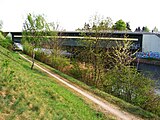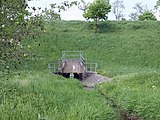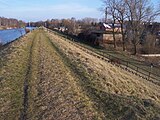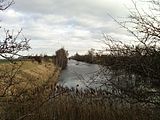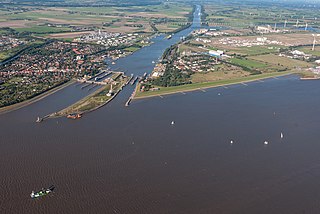
The Kiel Canal is a 98-kilometer-long (61 mi) fresh water canal that links the North Sea to the Baltic Sea. It runs through the German state of Schleswig-Holstein, from Brunsbüttel to the Holtenau district of Kiel. It was constructed from 1887 to 1895 and widened from 1907 to 1914. In addition to the two sea entrances, at Oldenbüttel the Kiel Canal is linked to the navigable River Eider by the short Gieselau Canal.

The Elbe is one of the major rivers of Central Europe. It rises in the Giant Mountains of the northern Czech Republic before traversing much of Bohemia, then Germany and flowing into the North Sea at Cuxhaven, 110 kilometres northwest of Hamburg. Its total length is 1,094 km (680 mi).

Halle (Saale), or simply Halle (German:[ˈhalə]; from the 15th to the 17th century: Hall in Sachsen; until the beginning of the 20th century: Halle an der Saale ; from 1965 to 1995: Halle/Saale) is the largest city of the German state of Saxony-Anhalt. It is the fifth-most populous city in the area of former East Germany after (East) Berlin, Leipzig, Dresden and Chemnitz, as well as the 31st-largest city of Germany. With around 244,000 inhabitants, it is slightly more populous than the state capital, Magdeburg. With Leipzig, the largest city of Saxony, Halle forms the polycentric Leipzig-Halle conurbation. Leipzig/Halle International Airport lies between the two cities, in Schkeuditz. The Leipzig-Halle conurbation is at the heart of the larger Central German Metropolitan Region.

The Saale, also known as the Saxon Saale and Thuringian Saale, is a river in Germany and a left-bank tributary of the Elbe. It is not to be confused with the smaller Franconian Saale, a right-bank tributary of the Main, or the Saale in Lower Saxony, a tributary of the Leine.

The Mittelland Canal, also known as the Midland Canal, is a major canal in central Germany. It forms an important link in the waterway network of the country, providing the principal east-west inland waterway connection. Its significance goes beyond Germany as it links France, Switzerland and the Benelux countries with Poland, the Czech Republic and the Baltic Sea.
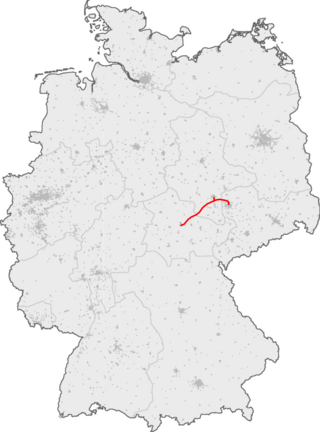
The Erfurt–Leipzig/Halle high-speed railway is a 123 km (76 mi)-long high-speed line in Germany between Erfurt and Leipzig and Halle, built as part of the Berlin–Munich high-speed railway.
Kreypau is a village and a former municipality in the district of Saalekreis, in Saxony-Anhalt, Germany. Since 31 December 2009, it is part of the town Leuna.
Ernst KarlErdmann Heine was a lawyer in Leipzig and a major entrepreneur and industrial pioneer who shaped the face of the western suburbs of Leipzig.
The Halle–Bebra railway, known in German as the Thüringer Bahn, is a 210 kilometre-long railway line from Halle (Saale) via Erfurt and Gerstungen to Bebra, mainly in Thuringia. As far as Gerstungen the line originally belonged to the Thuringian Railway Company. From Gerstungen to Bebra, it was owned by the Frederick William Northern Railway (Friedrich-Wilhelms-Nordbahn), named after the Prussian king, Frederick William IV. It is now a two-track, electrified, standard gauge mainline operated by DB Netze. It was opened between 1846 and 1849 and was the first railway line in Thuringia. All types of trains from Regionalbahn to ICE currently run on the line except Interregio-Express. Four of the six largest cities in Thuringia are located on the line.

Lindenau is a locality of Leipzig, in Saxony, Germany. It is part of the Stadtbezirk (borough) Alt-West.

The Leipzig Bay(German: Leipziger Tieflandsbucht) or Leipzig Basin or Saxon Lowland or Saxon Bay is a very flat, originally lakeless and highly fertile plain in Central Germany, in northwestern Saxony and southeastern Saxony-Anhalt, anchored by the foothills of the Harz mountains in the northwest and of the Ore Mountains in the southeast.
The Halle-Sorau-Guben Railway Company (Halle-Sorau-Gubener Eisenbahn-Gesellschaft was a private German railway company, which was founded in 1868 in Berlin. From 1872, its headquarters were in Halle an der Saale.

The Philharmonische Staatsorchester Halle was a symphony orchestra in Halle that existed from 1946 to 2006, which functioned as a concert orchestra and was last predominantly supported by the Land of Saxony-Anhalt. As a result of the fusion with the Orchester des Opernhauses Halle, the Orchestra was merged into the Staatskapelle Halle in 2006.
Yolanda Klug was a German woman who disappeared on 25 September 2019 and whose disappearance had been linked to Scientology. A walker discovered her remains on February 25, 2023 in the forest area Rödel near Freyburg. The cause of death is currently unclear.
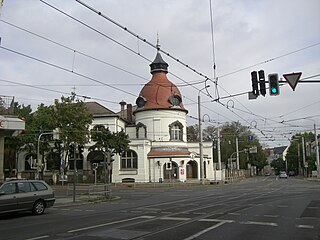
Karl-Heine-Strasse is a radial road in the west of Leipzig marking the boundary between the current localities of Leipzig-Plagwitz and Leipzig-Lindenau . 2.01 km (1.2 mi) long, it is named after the industrialist Karl Heine.

The Elsterwerda–Grödel raft canal, established in the 18th century, serves as a waterway connecting the Pulsnitz River in Elsterwerda with the Elbe River near Grödel in Germany.

The Karl Heine Canal is an approximately 3.3 km (2 mi) long artificial watercourse in the west of the city of Leipzig in Germany and connects the Lindenau harbor with the White Elster River. It is spanned by 15 bridges and is navigable with small boats. The canal is under monument protection as a monument preservation entity “canal, bank reinforcements and bridges”.

Schleußig is a locality of Leipzig in Germany. It is in the borough (Stadtbezirk) Südwest (southwest).

Bodies of water in Leipzig are the rivers White Elster, Pleiße and Parthe as well as numerous streams with the Leipzig Riverside Forest in Leipzig, Germany. Many of these watercourses have been diverted, canalised or drained for economic use, to defend the city and to protect against flooding, and new ditches and canals have also been built. A large number of ponds and lakes have also been created for fish farming, for urban planning reasons or as a result of open cast mining.



